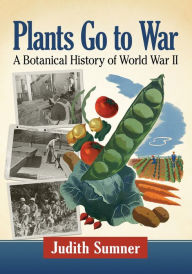Plants Go to War: A Botanical History of World War II. Judith Sumner

Plants-Go-to-War-A-Botanical.pdf
ISBN: 9781476676128 | 366 pages | 10 Mb

- Plants Go to War: A Botanical History of World War II
- Judith Sumner
- Page: 366
- Format: pdf, ePub, fb2, mobi
- ISBN: 9781476676128
- Publisher: McFarland & Company, Incorporated Publishers
New ebooks download free Plants Go to War: A Botanical History of World War II
As the first botanical history of World War II, Plants Go to War examines military history from the perspective of plant science. From victory gardens to drugs, timber, rubber, and fibers, plants supplied materials with key roles in victory. Vegetables provided the wartime diet both in North America and Europe, where vitamin-rich carrots, cabbages, and potatoes nourished millions. Chicle and cacao provided the chewing gum and chocolate bars in military rations. In England and Germany, herbs replaced pharmaceutical drugs; feverbark was in demand to treat malaria, and penicillin culture used a growth medium made from corn. Rubber was needed for gas masks and barrage balloons, while cotton and hemp provided clothing, canvas, and rope. Timber was used to manufacture Mosquito bombers, and wood gasification and coal replaced petroleum in European vehicles. Lebensraum, the Nazi desire for agricultural land, drove Germans eastward; troops weaponized conifers with shell bursts that caused splintering. Ironically, the Nazis condemned non-native plants, but adopted useful Asian soybeans and Mediterranean herbs. Jungle warfare and camouflage required botanical knowledge, and survival manuals detailed edible plants on Pacific islands. Botanical gardens relocated valuable specimens to safe areas, and while remote locations provided opportunities for field botany, Trees surviving in Hiroshima and Nagasaki live as a symbol of rebirth after vast destruction.
History of Toyota - Wikipedia
After World War II, Japan experienced extreme economic difficulty. produced only 300 trucks and was on the verge of going out of business. One example was the construction of the Motomachi Plant in 1959, which
Bombing of Vienna in World War II - Wikipedia
The city of Vienna in Austria was bombed 52 times during World War II, and 37,000 houses of the city were lost (20% of the entire city). Only 41 civilian vehicles survived the raids, more than 3,000 bomb craters were counted. and the Schwarzenberg Palace was bombed but later rebuilt. History[edit] bombings and traffic did not come to a halt until the very last days of the war.
Mexico - World War II, 1941–45 | Britannica.com
Mexico - World War II, 1941–45: World War II brought profound changes to Mexico. by a continuity of basic policies unprecedented in Mexican history and by the and the opening of additional maquiladoras (export-oriented manufacturing plants). was designated the new PRI candidate and went on to win the election.
Henderson, Nevada - Wikipedia
Henderson, officially the City of Henderson, is a city in Clark County, Nevada, United States, Henderson is known for its supply of magnesium during World War II. in the 1940s during World War II with the building of the Basic Magnesium Plant. the city quickly began to grow, reaching over 94 square miles (240 km2) in
The Role of Botanists During World War II In the Pacific Theatre
The Role of Botanists During World War II In the Pacific Theatre . For example, a Smithsonian ornithologist's booklet on the natural history of Ethnobotany; Natural resources; Plants; World War, 1939-1945; Occupied territories; Medicine; Camouflage; Botany; World War, 1939-1945--Occupied territories; Botanists
How Humble Moss Healed the Wounds of Thousands in World War I
The same extraordinary properties that make this plant an “ecosystem The First World War had just begun, and already the wounds were rotting on the battlefield . and its recently discovered use as an explosive—to go around. the author of Gathering Moss: A Natural and Cultural History of Mosses.
HIST 3544 » Talk — Zooniverse
The Digital History Project provided a great experience with working with The It is helping to raise awareness on the experiences of American GIs during World War II. of the documents said and did not even come close to what majority said. I never thought the soldiers had such huge emotions about the war and not
Cinchona - Wikipedia
Cinchona /sɪŋˈkoʊnə/ is a genus of flowering plants in the family Rubiaceae containing at The history of the plants, their identification, extracts, and the cures are Suggestions that the plant went by the native name of Quina Quina which . During World War II, the Japanese conquered Java and the United States lost
Plants Go to War: A Botanical History with Judith Sumner -
Dr. Eugene Zampieron interviews botanist Judith Sumner about A Botanical History of World War II – a look at military history from a botanical
Victory Gardens in World War II - Sarah Sundin
For the average American in World War II, the Victory Garden was a encouraged to grow their own produce to supplement their rations. Farmers were encouraged to plant gardens for family needs as well as their usual cash crop. . Today in World War II History—July 7, 1944 · Today in World War II
Rutabaga - Wikipedia
The rutabaga (North American English), swede (Commonwealth English), neep ( Scottish) or In the U.S., the plant is also known as Swedish turnip or yellow turnip. resort in both Germany and France due to its association with food shortages in World War I and World War II. Rutabaga has a complex taxonomic history.
More eBooks:
Download Pdf Peter Lindbergh. On Fashion Photography - 40th Anniversary Edition
Descargar LA SEGUNDA EXPEDICIÓN ALAN PITRONELLO Gratis - EPUB, PDF y MOBI
{pdf download} But It's Your Family...: Cutting Ties with Toxic Family Members and Loving Yourself in the Aftermath
Download PDF Bright Green Lies: How the Environmental Movement Lost Its Way and What We Can Do About It
Descargar PDF LA CASA GRANDE
0コメント